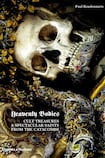
This may be the strangest book you’ll read all year. Or perhaps ever. Who among us was previously familiar with the Counter-Reformation practice of bejewelling skeletons and displaying them in German churches?
It's the photographs that will make you pick up this book, even if just to make sure you're not hallucinating. Only one photograph in Heavenly Bodies depicts living people. All the rest are of skeletons, or parts of skeletons. They are all almost entirely decorated with gemstones; some are also wrapped in richly embroidered lace or tulle. Gold threads simulate hair, lips made of rows of pearls frame sets of teeth, sapphire-blue stones lie like still pools in eye sockets. There are rib cages that resemble jewelled shields, fragments of femurs and patellas like decorated daggers, and complete skeletons dressed in the brocade of noblemen, some reclining on elbows as they stare out from behind glass coffins.
These photographs make the late Alexander McQueen’s skulls seem as cute as bunnies and Damien Hirst’s infamous diamond skull as innocuous as a Happy Meal toy. In 1860, viewing one of the skeletons pictured in this book, at the Benedictine Abbey of St Emmeran in Regensburg, Germany, a visitor described “Horrible, ghastly images, with jewels of great splendour in their sockets where the eyes should be, and in the nostrils, on the mouth . . .”
Paul Koudounaris also wrote The Empire of Death: A Cultural History of Ossuaries and Charnel Houses. His subjects are the rituals associated with Christian death and veneration of relics, and this new book is a visceral reminder of how esoteric some of them have been.
In the 17th and 18th centuries many sets of bones were removed from Roman catacombs and sent to churches in the then German-speaking regions. The bones were not of saints, but it was thought some were of martyrs, who had sacrificed their lives for their faith, hence the term “catacomb saints”, which inspired this book’s title. Provenance seemed to matter less and less the farther these bones went from the Roman catacombs.
The Catholic Church used the skeletons as tools in the Counter-Reformation. First the bones were articulated – which is to say connected – to re-create the skeletons. Then they were decorated. One of the endpapers of Koudounaris’s book carries his dedication: “To the anonymous hands that decorated the bones that line these pages, in the hope that their beautiful work will not be forgotten.”
Those hands belonged mainly to nuns, who worked lace to wrap bones in, then stitched it with gold thread and fantastical jigsaws of gems. As Koudounaris writes, “Not only did nuns have the proper religious temperament to pay appropriate deference to sacred items, many convents were also renowned for their skill in the necessary decorative and textile arts.” One skeleton in Salem Abbey was decorated with more than 1,000 gems, including diamonds, rubies and emeralds.
The decoration of relics with precious objects remains common in many religions. In Bagan, in Burma, I once paid the equivalent of 1c to rent a telescope through which to look at a richly jewelled object atop a holy stupa, and in Mandalay I visited the Mahamuni Buddha, whose shape has been rendered unrecognisable by male worshippers’ application over centuries of squares of gold leaf.
The Catholic Church was the main funder of the decoration of the skeletons, which were then put on prominent view in churches, to be venerated. Wealthy Catholics donated rings to be placed on skeletal fingers, or gems for the chest, which was the showpiece of all skeletons. A Counter-Reformation may have been going on in a wider context, but the extraordinary “catacomb saints” drew the faithful back to the churches. Several had elaborate annual rituals involving parades though their towns.
People soon credited some skeletons with healing powers, so encouraging even more devotees to visit. The phenomena of their day, they must have created an extraordinary stir in the towns and cities of the churches they were sent to.
So what happened to them? Secularisation, mainly. In time, robbers filleted off many of the precious gems. They became an embarrassment. Clergy relegated them to attics, to storage, to crypts out of sight, behind sealed-up walls or painted panels, away from their previously prominent positions.
But some remain, and Koudounaris has tracked them down. You can, for instance, if you go to Porrentruy, in Switzerland, see the skeleton of St Faustine, which was displayed in the church there until 1978. It’s now in a nearby storage unit at the back of a garage.
The only living people photographed in this book are from Roggenburg, in Germany. On August 15th each year, their catacomb saints are paraded around the grounds of the church, held aloft by those who still venerate them. After reading this book, I’m minded to go there next year.
Heavenly Bodies, Cult Treasures and Spectacular Saints from the Catacombs, By Paul Koudounaris, Thames & Hudson, 192pp, £18.95
Rosita Boland is an irish Times journalist












